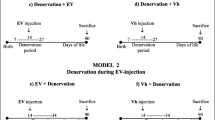Abstract
THE concentration of hypothalamic noradrenaline changes during the oestrous cycle, and after castration in rats. During pro-oestrus and after castration, high values of noradrenaline are found. During oestrus the concentration of this amine in the rat anterior hypothalamus is low1,2. The ovarian hormones, oestradiol and progesterone, when administered simultaneously, reduce noradrenaline and increase dopamine in the anterior part of the hypothalamus of spayed rats practically to the levels found in normal oestrous rats3. This may mean that sex steroids exert a negative feedback influence on the adrenergic effectors in the hypothalamus.
Access this article
We’re sorry, something doesn't seem to be working properly.
Please try refreshing the page. If that doesn't work, please contact support so we can address the problem.
Similar content being viewed by others
References
Stefano, F. J. E., and Donoso, A. O., Endocrinology, 81, 1405 (1967).
Donoso, A. O., Stefano, F. J. E., Biscardi, A. M., and Cukier, J., Amer. J. Physiol., 212, 737 (1967).
Donoso, A. O., and Stefano, F. J. E., Experientia, 23, 665 (1967).
Barraclough, C. A., Rec. Prog. Hormone Res., 22, 503 (1966).
Author information
Authors and Affiliations
Rights and permissions
About this article
Cite this article
DONOSO, A., CUKIER, J. Oestrogen as Depressor of Noradrenaline Concentration in the Anterior Hypothalamus. Nature 218, 969–970 (1968). https://doi.org/10.1038/218969a0
Received:
Revised:
Issue Date:
DOI: https://doi.org/10.1038/218969a0
- Springer Nature Limited
This article is cited by
-
Historical studies of premenstrual tension up to 30 years ago: Implications for future research
Current Psychiatry Reports (2002)
-
Changes in monoamine content in various regions of the hypothalamus in different stages of the estrous cycle
Neuroscience and Behavioral Physiology (1976)
-
The influence of hypothalamically administered reserpine on the sexual behavior of the female cat
Psychopharmacology (1976)
-
Monoamines and ovarian hormone-linked sexual and emotional changes: A review
Archives of Sexual Behavior (1971)





